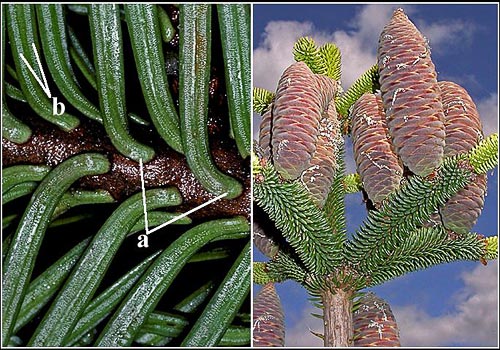Relatives
Abies sibirica Ledeb. - Siberian Fir.
Taxonomic position.
Family Pinaceae Lindl. genus Abies Mill.Morphology and biology.
Tree is up to 30 m tall and 55 cm across; bark is dark grey, smooth; crown narrow-pyramidal, with branches from the very base; young branches covered with brownish hairs. Leaves 1.5.5 cm long and 1.1.7 mm wide, with rounded or obtuse, not deeply emarginate tip, not rigid; cones oval-cylindrical, 5.9 cm long and 2.4 cm wide, young ones dark purple, mature light brown, seed scales flatly rounded, finely notched at margins with velvety outer surface, bract scales 3 times shorter than seed ones; seeds obliquely obovate, 7 mm long, slightly pubescent, wing semiobovate, 8.10 mm long and 7.8 mm wide. Monoecious, anemophilous, anemochore. 2n=?Distribution.
Northeastern European part, Urals, West Siberia, Altai, East Siberia (central and southern parts), Kazakhstan (Tarbagatai, Dzungarian Alatau); Northern Mongolia, Northwestern China.Ecology.
Forests with dominance of Siberian fir or with its participation, along with spruce and Siberian pine, form the "dark" taiga of Siberia. Less often, occurs as an admixture in pine and larch forests, in the European part in broad-leaved forests, in mountains of southern Siberia in lime forests. In the Polar Ural up to 600 m a.s.l., in Altai up to 2400 m a.s.l.Use and economic value.
Wood light and soft, has no heart or resin ducts; used poorly.References:
Sokolov SI., Svjaseva OA., Kubli VA. 1977. Ranges of trees and shrubs of the USSR. V.1. Leningrad: Nauka. 240 p. (In Russian).Tolmachev AI., ed. 1974. Flora of the North-East of European part of the USSR. V.1. Leningrad: Nauka. 275 p. (In Russian).
Krasnoborov IM., ed. 1988. Flora of Siberia. V.1. Lycopodiaceae - Hydrocharitaceae. Novosibirsk: Nauka. 199 p. (In Russian).


